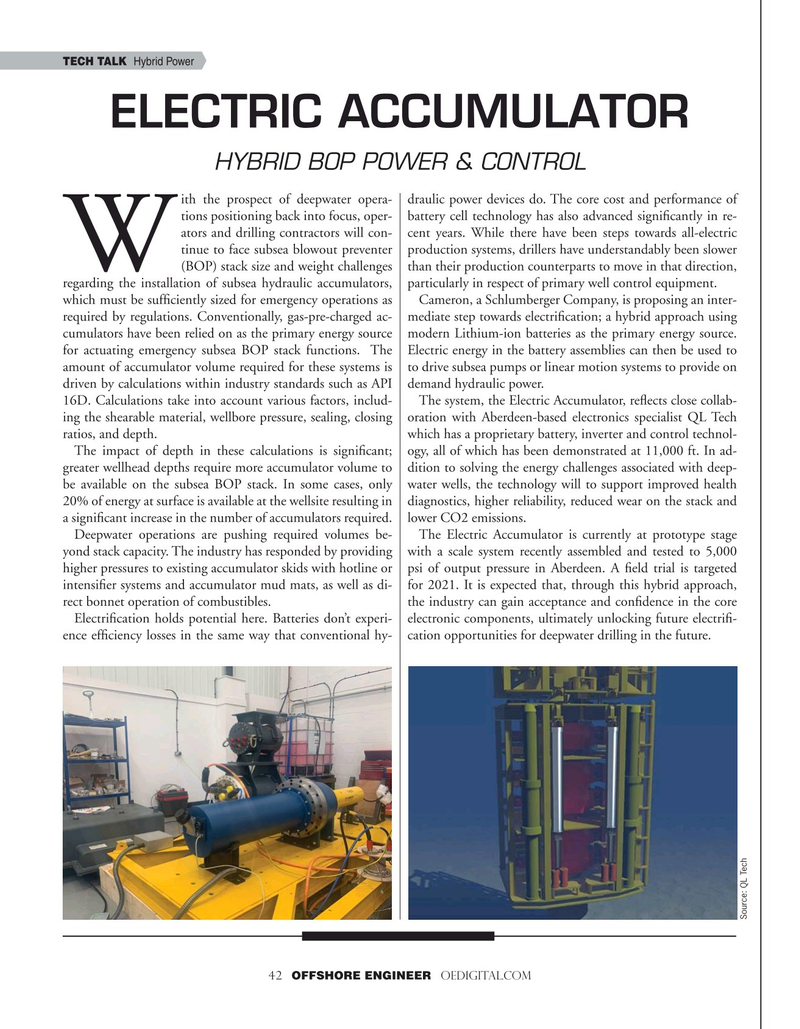
Page 42: of Offshore Engineer Magazine (Jul/Aug 2020)
Read this page in Pdf, Flash or Html5 edition of Jul/Aug 2020 Offshore Engineer Magazine
TECH TALK Hybrid Power
ELECTRIC ACCUMULATOR
HYBRID BOP POWER & CONTROL ith the prospect of deepwater opera- draulic power devices do. The core cost and performance of tions positioning back into focus, oper- battery cell technology has also advanced signi?cantly in re- ators and drilling contractors will con- cent years. While there have been steps towards all-electric tinue to face subsea blowout preventer production systems, drillers have understandably been slower
W (BOP) stack size and weight challenges than their production counterparts to move in that direction, regarding the installation of subsea hydraulic accumulators, particularly in respect of primary well control equipment.
which must be suf?ciently sized for emergency operations as Cameron, a Schlumberger Company, is proposing an inter- required by regulations. Conventionally, gas-pre-charged ac- mediate step towards electri?cation; a hybrid approach using cumulators have been relied on as the primary energy source modern Lithium-ion batteries as the primary energy source. for actuating emergency subsea BOP stack functions. The Electric energy in the battery assemblies can then be used to amount of accumulator volume required for these systems is to drive subsea pumps or linear motion systems to provide on driven by calculations within industry standards such as API demand hydraulic power. 16D. Calculations take into account various factors, includ- The system, the Electric Accumulator, re?ects close collab- ing the shearable material, wellbore pressure, sealing, closing oration with Aberdeen-based electronics specialist QL Tech ratios, and depth. which has a proprietary battery, inverter and control technol-
The impact of depth in these calculations is signi?cant; ogy, all of which has been demonstrated at 11,000 ft. In ad- greater wellhead depths require more accumulator volume to dition to solving the energy challenges associated with deep- be available on the subsea BOP stack. In some cases, only water wells, the technology will to support improved health 20% of energy at surface is available at the wellsite resulting in diagnostics, higher reliability, reduced wear on the stack and a signi?cant increase in the number of accumulators required. lower CO2 emissions.
Deepwater operations are pushing required volumes be- The Electric Accumulator is currently at prototype stage yond stack capacity. The industry has responded by providing with a scale system recently assembled and tested to 5,000 higher pressures to existing accumulator skids with hotline or psi of output pressure in Aberdeen. A ?eld trial is targeted intensi?er systems and accumulator mud mats, as well as di- for 2021. It is expected that, through this hybrid approach, rect bonnet operation of combustibles. the industry can gain acceptance and con?dence in the core
Electri?cation holds potential here. Batteries don’t experi- electronic components, ultimately unlocking future electri?- ence ef?ciency losses in the same way that conventional hy- cation opportunities for deepwater drilling in the future.
Source: QL Tech 42 OFFSHORE ENGINEER OEDIGITAL.COM

 41
41

 43
43